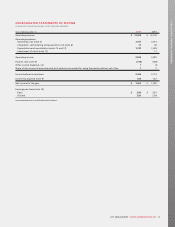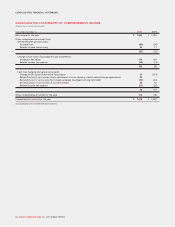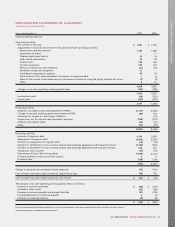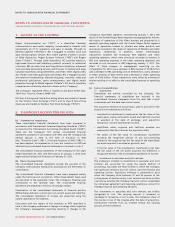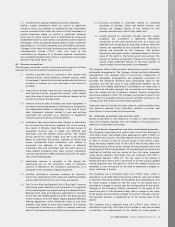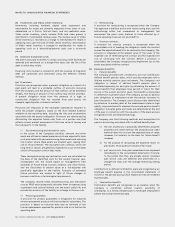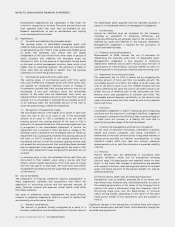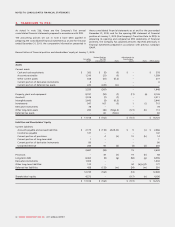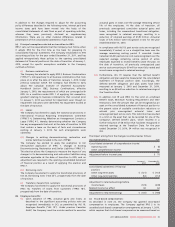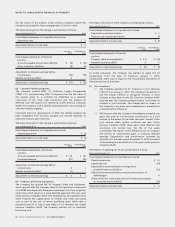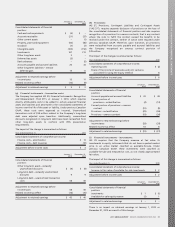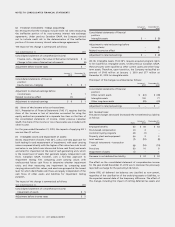Rogers 2011 Annual Report Download - page 93
Download and view the complete annual report
Please find page 93 of the 2011 Rogers annual report below. You can navigate through the pages in the report by either clicking on the pages listed below, or by using the keyword search tool below to find specific information within the annual report.
NOTES TO CONSOLIDATED FINANCIAL STATEMENTS
(o) Property, plant and equipment:
(i) Recognition and measurement:
Items of PP&E are measured at cost less accumulated depreciation
and accumulated impairment losses. Cost includes expenditures
that are directly attributable to the acquisition of the asset. The
cost of self-constructed assets includes the cost of materials and
direct labour, any other costs directly attributable to bringing the
assets to a working condition for their intended use, the costs of
dismantling and removing the items and restoring the site on
which they are located, and borrowing costs on qualifying assets
for which the commencement date of acquisition, construction or
development is on or after January 1, 2010.
The cost of the initial cable subscriber installation is capitalized.
Costs of other cable connections and disconnections are
expensed, except for direct incremental installation costs related
to reconnect Cable customers, which are deferred to the extent
of reconnect installation revenues. Deferred reconnect revenues
and expenses are amortized over the related estimated service
period.
When parts of an item of PP&E have different useful lives, they
are accounted for as separate components of PP&E.
Gains and losses on disposal of an item of PP&E are determined
by comparing the proceeds from disposal with the carrying
amount of PP&E, and are recognized within other income in the
consolidated statements of income.
(ii) Subsequent costs:
Subsequent costs are included in the asset’s carrying amount or
recognized as a separate asset only when it is probable that
additional future economic benefits associated with the
subsequent expenditures will flow to the Company and the costs
of the item can be reliably measured. All other expenditures are
charged to operating expenses as incurred.
(iii) Depreciation:
PP&E are stated at cost less accumulated depreciation and any
impairment losses.
Depreciation is charged to the consolidated statements of income over their estimated useful lives as follows:
Asset Basis Rate
Buildings Mainly diminishing balance 4% to 18%
Towers, head-ends and transmitters Straight-line 6-2/3% to 25%
Distribution cable and subscriber drops Straight-line 5% to 20%
Network equipment Straight-line 6-2/3% to 33-1/3%
Wireless network radio base station equipment Straight-line 12-1/2% to 14-1/3%
Computer equipment and software Straight-line 14-1/3% to 33-1/3%
Customer equipment Straight-line 20% to 33-1/3%
Leasehold improvements Straight-line Over shorter of estimated
useful life and lease term
Equipment and vehicles Mainly diminishing balance 5% to 33-1/3%
Depreciation methods, rates and residual values are reviewed
annually and revised if the current method, estimated useful life
or residual value is different from that estimated previously. The
effect of such changes is recognized in the consolidated
statements of income prospectively.
(p) Acquired program rights:
Program rights represent contractual rights acquired from third parties to
broadcast television programs. Acquired program rights for broadcasting
are carried at cost less accumulated amortization, and accumulated
impairment losses, if any. Acquired program rights and the related
liabilities are recorded on the consolidated statements of financial position
when the licence period begins and the program is available for use. The
cost of acquired program rights is amortized to other external purchases
in the consolidated statements of income over the expected exhibition
period of 1 to 5 years. If program rights are not scheduled, they are
considered impaired and written off. Otherwise, they are subject to
non-financial asset impairment testing as intangible assets with finite
useful lives. Program rights for multi-year sports programming
arrangements are expensed as incurred, when the games are aired.
(q) Goodwill and intangible assets:
(i) Goodwill:
Goodwill is the amount that results when the fair value of
consideration transferred for an acquired business exceeds the net
fair value of the identifiable assets, liabilities and contingent
liabilities recognized. When the Company enters into a business
combination, the acquisition method of accounting is used.
Goodwill is assigned, as of the date of the business combination, to
cash generating units that are expected to benefit from the business
combination. Each cash generating unit represents the lowest level
at which goodwill is monitored for internal management purposes
and it is never larger than an operating segment.
(ii) Intangible assets:
Intangible assets acquired in a business combination are
recorded at their fair values. Intangible assets with finite useful
lives are amortized over their estimated useful lives and are
tested for impairment, as described in note 2(r). Useful lives,
residual values and amortization methods for intangible assets
with finite useful lives are reviewed at least annually.
Intangible assets having an indefinite life, being spectrum and
broadcast licences, are not amortized but are tested for
impairment on an annual basis, as described in note 2(r).
Spectrum licences and broadcast licences are indefinite life
intangible assets, because there is no foreseeable limit to the
period over which these assets are expected to generate net cash
inflows for the Company. The determination of these assets’
indefinite life is based on an analysis of all relevant factors,
including the expected usage of the asset, the typical life cycle of
the asset and anticipated changes in the market demand for the
products and services that the asset helps generate.
Intangible assets with finite useful lives are amortized on a
straight-line basis over their estimated useful lives as follows:
Brand names 5 to 20 years
Customer relationships 2 to 5 years
Roaming agreements 12 years
Marketing agreements 2 to 5 years
During the year ended December 31, 2011, no significant
changes were made in estimated useful lives compared to 2010.
2011 ANNUAL REPORT ROGERS COMMUNICATIONS INC. 89


